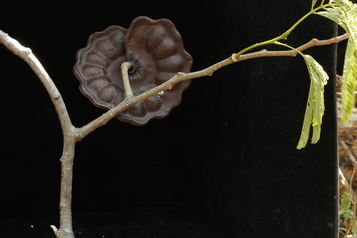be'za' yaga Name given to the species <Enterolobium cyclocarpum>. This tree, [...]
| Part of Speech | s |
| PDLMA | be7za yaga |
| Speaker | {EJG,JLC,VP,RLC10,FSL12,FSL15} |
-
- Name given to the species <Enterolobium cyclocarpum>. This tree, known in Spanish as <guanacastle> or <huanacastle>, has a large crown and can reach a height of more than 30 meters. It is abundant in La Ventosa. It produces dark brown pods that twist around in a unique circular shape. The pods can be used as a detergent for washing clothes, because when rubbed together they produce a foamy substance. The seeds of the pods can be used to make necklaces. The wood of the tree can be used to make furniture as well as door and window frames. Sometimes little girls use the sap to glue a small piece of wood onto the heel of their shoes to play dress-up. It is said that putting twigs from this tree in a parrot's cage can boost the growth of feathers in the most sought-after colors.
- Guanacastle, huanacastle. Nombre que se le da a la especie <Enterolobium cyclocarpum>. Árbol de amplia copa que alcanza alturas de más de 30 metros. Se encuentra de manera abundante en La Ventosa. Su madera se ha utilizado para la fabricación de muebles y de marcos para puertas y ventanas. Sus frutos son vainas de color café oscuro y tienen la peculiaridad de estar retorcidas en forma de espiral. La vaina se ha utilizado como jabón para lavar la ropa debido a que al frotarse saca espuma. La semillas se pueden usar para hacer collares. La resina la usaban las niñas para pegar un trocito de madera en el talón de los zapatos y hacerse zapatos de tacón para jugar. Se dice que las ramitas se usan para fomentar el crecimiento de plumas de colores más deseables en los loros en cautiverio. [Spanish]
- Nacani ti yaga ro' nabé rucheeche na', nasooni bia' gandebichii metru, lu diidxaxtia rabicabeni 'huanacastle'. Nuu caadxi rigola náca' cadi ládi'ni 'bezayaga' laani láni 'yaga be'za diaga'. Napani ti xca rindani lu gusiba nabé nayaahui, rului´ni ti diaga dopa cuuxhu nayu cahui. Dxique gudiibinecabeni lari purti raca bichiiñani. Biidxi xtini runicabe laa biga'. Ne yaga xtini ruza'necabe ndagayoo ne ndagabiaani'. Ca dxapahuiini ora ma' caguiteca' nacaca' huada' ricaaca' niidxi xtini rune'cani lu ti ndaa yaga ne ruquiidicani lu xti ndaa yaga bata, zaca ruza'ca ti guidibo'co nasoo xatini ñee. Nuu binni ná pa guyaanacabe ca xpandagani ca gudxu' la? zaree ca xtuubicame sicaru. Yaga nacha'hui'ni. [Diidxazá]
-
-
Example 8:
be'za' yaga ca la? ti yaga naro'bani la? rácani de chii bia' ne bandga stìni la?, rusábani bandaga la?, tiempo de abril ca la? ma cabeeni xpadagani verde ri'ni la? ne riquiiñecabeni, dxiqué nuu loro la?, ruchuugucabe ca bandaga riini ca la? ruguunecabeni loro la? para igaa xhiaame para chuuneme la? igaa xhiaa igaane xiàme ngá nga be'za' yaga ne ricá ti semiá redondo luni, lui' casi diaga binni láthe be'za' yaga is a large tree, it grows as much as ten meters tall, it looses its leaves and in April the leaves grow back in the past it was used, there used to be parrots, people would harvest young leaves and given them to the parrots to make their wings grow, so that they take them to grow their wings that's the be'za' yaga, it produces a round seed pod, it resembles a person's earel guanacastle es un árbo grande, crece unos diez metros y su hoja, se caen sus hojas, el mes de abril saca sus hojas verdes (tiernas) y lo utilizan, antes habían loros, cortaban las hojas tiernas y se lo ponían al loro para que crecieran sus alas, para que se lo pongan y crescan sus alas ese es el guanacastle y da una semilla redonda, parece la oreja de una persona [Spanish]
-
Taxa <Enterolobium cyclocarpum>







